
08 Feb Books: Reading the West
American Wolf: A True Story of Survival and Obsession in the West by Nate Blakeslee (Crown, $28) is a book about the famous Yellowstone wolves, specifically the uncommonly popular wolf known as O-Six. As with all books about the Yellowstone wolves, it is also a story about people. Framed as a biography of O-Six (named for the year in which she was born), American Wolf explores the legal, political, and emotional issues surrounding the reintroduction of wolves to the West and their evolving relationship with humans. O-Six was born in the Greater Yellowstone Ecosystem just over 10 years after wolves were first reintroduced to the park and close to 90 years after the magnificent canines were nearly eradicated from the lower 48. Her popularity among wolf watchers and wildlife biologists — and her unlikely turn as a star on social media — meant that Blakeslee had a trove of information to work from as he brought together the story of O-Six and the realities of human-wildlife interactions in the 21st century.
Camera phones and social media launched O-Six’s meteoric career when she began to be routinely spotted by wolf watchers and lucky tourists. Wolves, of course, don’t notice that there are people pointing devices at them to capture their behavior — so they don’t stop what they’re doing just because someone is watching. O-Six and her pack were easy to spot as they went about their business in the northern reaches of Yellowstone, and it was easy for human watchers to endow her with the anthropomorphic characteristics, like leadership and a sense of humor, that made her so popular.
Blakeslee’s approach was not just to tell the story of O-Six’s life but also to reveal the ongoing battles in the courts and in public policy debates over reintroduction. By the time of O-Six’s life and her growing fame, the fight was no longer about the pros and cons of reintroduction. The conversation had shifted to whether reintroduction had been successful enough to justify taking wolves off the endangered species list and reintroducing wolf hunts. Unfortunately, that’s where O-Six’s story ends and her legend and legacy begins.
When she takes her pack farther afield — as wolves do — she’s killed in one of the first legal hunts, and the outrage over her death becomes another part of her story. Blakeslee’s interviews with the hunter who shot her make up an important — and poignant — part of the book. O-Six’s life story is preserved in the photos and videos and articles and books about her, a record rare for a wild animal. But because people “knew” her, she left behind a legacy of further conversation about wolf management that seems less abstract and more personal. The outrage over her death and the hunter’s reactions are significant aspects of her tale, and the documentation of her life will likely be a part of future discussions about wildlife management.
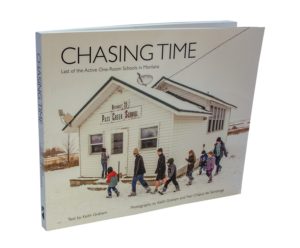 Make no mistake, Chasing Time: Last of the Active One-Room Schools in Montana by Keith Graham and Neil Chaput de Saintonge (Riverbend, $32.95) is a beautiful photo book filled with evocative images, but it’s also a guidebook that offers glimpses into the past and a view of the future. The past that the book depicts still exists in nearly 70 school buildings scattered across the Montana landscape. The lessons learned in those buildings offer interesting perspectives on the future of education, posing questions about class sizes and vertical integration of education, and demonstrating how technology can be an effective tool in classrooms.
Make no mistake, Chasing Time: Last of the Active One-Room Schools in Montana by Keith Graham and Neil Chaput de Saintonge (Riverbend, $32.95) is a beautiful photo book filled with evocative images, but it’s also a guidebook that offers glimpses into the past and a view of the future. The past that the book depicts still exists in nearly 70 school buildings scattered across the Montana landscape. The lessons learned in those buildings offer interesting perspectives on the future of education, posing questions about class sizes and vertical integration of education, and demonstrating how technology can be an effective tool in classrooms.
The concept of a one-room school serving students from ages 5 to 18 seems strange and antiquated in the 21st century. Montana is unusual in terms of the number of one-room schools that still exist in the state — especially given that there are only about 200 remaining in all of the U.S., down from 20,000 in 1912. The Montana schools still exist for a variety of reasons, including the distance between neighboring schools, remote locations and barriers to travel, Hutterite communities’ desires to keep their schools separate, and possibly the fierce independence of rural Montana communities.
In towns like Nye and Cooke City, these simple buildings — some historic, some hastily constructed to serve an immediate need — produce graduates who will go on to lives outside those small Montana communities. Quite a few of the schools featured in this book have fewer than 10 students in all grade levels. The pictures of the students and their teachers in front of these buildings paint only a part of the portrait of these special places. The short introductions to each story add to the picture, and the brief histories of the communities give a clue as to why the residents maintain such a connection to these schools.
The teachers and students interviewed for the book say many of the same things: It is a challenge for teachers to meet the needs of all learning levels every day; but smaller class sizes mean that education is individualized, and that students can move at their own pace. The multi-age learning environment allows for younger students to learn from older students — and vice versa. And time spent at a small kitchen table eating peanut butter or tuna sandwiches offers precious opportunities for one-on-one time with the teacher in an informal setting not often found in an elementary school cafeteria.
The stories and images included in the book are touching and sometimes surprising. In Bloomfield, 100 people will turn up for the annual Christmas program, and the community collects soup labels, box tops, and Coca-Cola points to help support programming at the school. In Cooke City, no student lives more than a mile from the school, and all five of them walk to their classroom. In all of the schools, smart boards, tablets, and modern materials give the children the same access to the world outside Montana that kids in Billings or Missoula might have.
The concept behind this book is simple, and the contents are both nostalgic and hopeful, demonstrating how these small places can help their communities remain relevant even while highlighting best practices in the classroom. The map showing the remaining one-room schools that can be found around the state, from Alzada to Yaak, demonstrates that a driving tour to visit each and every building would cover thousands of miles — which is what the authors did to take the photos and collect the stories that populate the pages of this book.
 A familiar Orvis logo in forest green arches across the front cover of The Orvis Guide to Upland Hunting (Universe/Rizzoli, $55). The photo that stretches from edge to edge is a study in light and contrast, featuring a pastoral landscape and a beautifully outfitted hunter reaching into his gear bag to load his shotgun. It’s an iconic look for this book — which promises on its dust jacket to be not just a hunting guide but also a guide for aspirations and dreams.
A familiar Orvis logo in forest green arches across the front cover of The Orvis Guide to Upland Hunting (Universe/Rizzoli, $55). The photo that stretches from edge to edge is a study in light and contrast, featuring a pastoral landscape and a beautifully outfitted hunter reaching into his gear bag to load his shotgun. It’s an iconic look for this book — which promises on its dust jacket to be not just a hunting guide but also a guide for aspirations and dreams.
The interior lives up to the promise of its cover, featuring gorgeous full-color images by outdoor photographer Brian Grossenbacher. His landscapes and portraits of men and women, dogs, birds, and guns evoke crisp early mornings in autumn. Diffuse light dapples forest floors in images that offer glimpses into the spectacular natural world where hunter and prey interact. Creased leather gloves and fine-feathered grouse wings get more intimate treatment, and together the images in this book show an idyllic world.
The organization of the guide, which offers a comprehensive introduction to bird species, dogs, guns, and other gear, is complemented not only by the imagery but also by a history of upland bird hunting. A short essay on “The What and the Why” succinctly provides justification for the continued existence of this type of hunting as a sport, and gives the raison d’etre for the book. Upland birds are a food species — not a trophy species. Author Reid Bryant’s thesis is that some of today’s hunters may need a reintroduction to the concepts of upland bird hunting. He posits that the refocus on locally sourced, seasonally appropriate food during the last decade has made hunting for food — if not critical — at least more relevant in our increasingly digital age. He offers that he’s “willing to bet that [our great-grandparents] all knew what a shotgun shell looked like, and, at some point, cleaned feathers from the kitchen sink.” His history of both the game and the sport, and his thoughtful contemplation of the hunter’s intention, enhances the other components of the book, including the identification photos of species (both bird and dog); guns, shells, and their attendant parts; and other critical gear. Still, even though this is an Orvis guide, it doesn’t feel like a commercial for the brand (even though you can see that logo in many of the photos). This is a thorough guide to the equipment, the species, and the ins and outs of public land versus private property. Even experienced hunters will find the thoughtful organization of the information presented and detailed directions in this book illuminating and the overall package inspiring.
OF NOTE
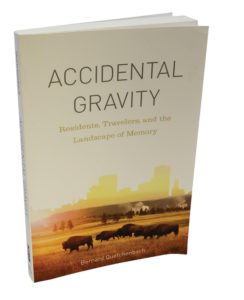 Accidental Gravity: Residents, Travelers, and the Landscape of Memory by Bernard Quetchenbach (Oregon State University Press, $22.95) is a collection of essays covering the key moments and places in the author’s life and tying them together with current environmental and political issues. The places where the two meet are the points of “accidental gravity.”
Accidental Gravity: Residents, Travelers, and the Landscape of Memory by Bernard Quetchenbach (Oregon State University Press, $22.95) is a collection of essays covering the key moments and places in the author’s life and tying them together with current environmental and political issues. The places where the two meet are the points of “accidental gravity.”
Quetchenbach’s prose is clearly infused with his poet’s eye and ear. The overarching structure of the book juxtaposes the natural world, suburban human-wildlife encounters, and the comparatively wild Yellowstone National Park — which increasingly is under pressure over how to handle wildfires and manage the impacts from an increasing numbers of tourists. These glimpses into the author’s life move from his childhood in New York to his adulthood in the West.
 The Bunch Grass Motel: The Collected Poems of Randall Gloege, edited by Bernard Quetchenbach (University of Montana Press, $15.95), paints pictures of age and youth, dry grass and mountain, and snow and heat with rhythm and simplicity. Gloege’s curiosity about nature, fascination with its detail, and facility with language results in beautiful images as fleeting as ravens’ wings and flurrying snow. Gloege’s exploration of the relationships between youth and age finds beauty in the details of a wrinkled hand and the beauty of young feet kicking soccer balls.
The Bunch Grass Motel: The Collected Poems of Randall Gloege, edited by Bernard Quetchenbach (University of Montana Press, $15.95), paints pictures of age and youth, dry grass and mountain, and snow and heat with rhythm and simplicity. Gloege’s curiosity about nature, fascination with its detail, and facility with language results in beautiful images as fleeting as ravens’ wings and flurrying snow. Gloege’s exploration of the relationships between youth and age finds beauty in the details of a wrinkled hand and the beauty of young feet kicking soccer balls.
Trout Tips: More Than 250 Trout Fishing Tips from the Members of Trout Unlimited,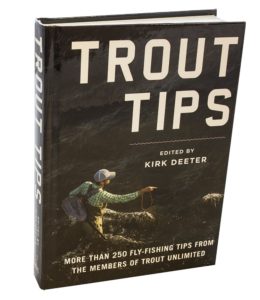 edited by Kirk Deeter (Skyhorse, $16.99), offers exactly what the title promises: tips from expert anglers — both men and women — that cover just about every possible aspect of fly fishing, from choosing your rod and line to casting techniques to tying your own flies. Illustrating the words of wisdom are dozens of color photographs and drawings. This is both a good beginner’s guide and an expert’s refresher course for every region where anglers quest after trout species.
edited by Kirk Deeter (Skyhorse, $16.99), offers exactly what the title promises: tips from expert anglers — both men and women — that cover just about every possible aspect of fly fishing, from choosing your rod and line to casting techniques to tying your own flies. Illustrating the words of wisdom are dozens of color photographs and drawings. This is both a good beginner’s guide and an expert’s refresher course for every region where anglers quest after trout species.
Nymph Masters: Fly-Fishing Secrets from Expert Anglers by Jason Randall (Stackpole, $34.95) similarly offers expert advice from giants in the field of fly fishing. The 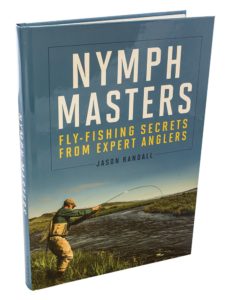 author travels from Pennsylvania to Alaska gathering clues from Lefty Kreh, Ed Jaworowski, Gary Borger, and others, with the intention of solving the puzzles of nymph fishing. Randall approaches scenarios and streams as individual problems and puts together answers using all of the resources at his disposal. Color photos and illustrations complete the package.
author travels from Pennsylvania to Alaska gathering clues from Lefty Kreh, Ed Jaworowski, Gary Borger, and others, with the intention of solving the puzzles of nymph fishing. Randall approaches scenarios and streams as individual problems and puts together answers using all of the resources at his disposal. Color photos and illustrations complete the package.
Writer Tim Weed’s short story collection, A Field Guide to Murder & Fly Fishing: Stories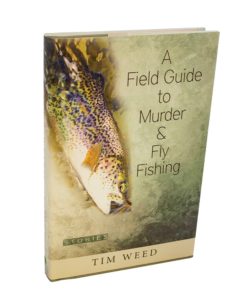 (Green Writer’s Press, $24.95) is unpredictable and full of adventure, pathos, and a bit of humor. Weed’s stories have been nominated for numerous awards and have appeared in a variety of literary magazines. They have their roots in the relationships between men and boys, and between men and nature, and they are colored by his long experience as a travel and adventure writer. His vivid settings range from the Great Lakes to the streets of Rome. His characters are fishermen, mountaineers, and teenagers all on a quest for self-discovery. From the title page to the last page, this is a book of gems.
(Green Writer’s Press, $24.95) is unpredictable and full of adventure, pathos, and a bit of humor. Weed’s stories have been nominated for numerous awards and have appeared in a variety of literary magazines. They have their roots in the relationships between men and boys, and between men and nature, and they are colored by his long experience as a travel and adventure writer. His vivid settings range from the Great Lakes to the streets of Rome. His characters are fishermen, mountaineers, and teenagers all on a quest for self-discovery. From the title page to the last page, this is a book of gems.
 In Feather Craft: The Amazing Birds and Feathers Used in Classic Salmon Flies, writer Kevin W. Erickson (Stackpole, $49.95) goes beyond the classic how-to by explaining not only the mechanics of tying 16 classic and modern salmon patterns, but also featuring the bird species that provide the feathers. Erickson’s premise is both simple and thoughtful: By featuring close-up photos of feathers and plumage, and details about species’ range, habitat, and habits, he makes a strong case for the preservation and conservation of the birds themselves. Charming color illustrations of the birds by Allison McKay complete the individual bird portraits, and the step-by-step instructions for tying the flies make this both a browser’s book and a useful guide.
In Feather Craft: The Amazing Birds and Feathers Used in Classic Salmon Flies, writer Kevin W. Erickson (Stackpole, $49.95) goes beyond the classic how-to by explaining not only the mechanics of tying 16 classic and modern salmon patterns, but also featuring the bird species that provide the feathers. Erickson’s premise is both simple and thoughtful: By featuring close-up photos of feathers and plumage, and details about species’ range, habitat, and habits, he makes a strong case for the preservation and conservation of the birds themselves. Charming color illustrations of the birds by Allison McKay complete the individual bird portraits, and the step-by-step instructions for tying the flies make this both a browser’s book and a useful guide.



No Comments